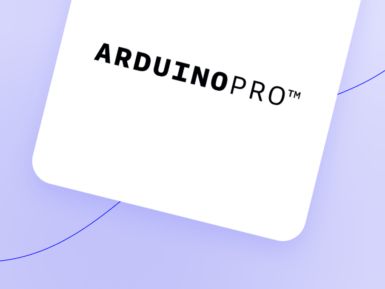
Arduino IoT Bundle
The Arduino IoT Bundle is the best way to start exploring the world of connected devices using the Arduino Nano RP2040 Connect. Follow the 5 step by step tutorials to quickly learn how to build IoT devices.
Overview
Follow the 5 step by step tutorials we have prepared for you and combining the electronic components included in the bundle, you’ll quickly learn how to build devices that connect to the Arduino IoT Cloud.
The 5 step by step tutorials are:
Arduino IoT Cloud Compatible
Tech specs
Each bundle includes:
- 1 Arduino Nano RP2040 Connect
- 1 micro USB cable
- 1 400-point breadboard
- 70 solid-core jumper wires
- 2 stranded jumper wire
- 6 phototransistors
- 3 potentiometers (10k ohm)
- 10 pushbuttons
- 1 temperature sensor (TMP36)
- 1 tilt sensor
- 1 alphanumeric LCD (16 x 2 characters)
- 1 bright white
- 28 LEDs (1 RGB, 8 red, 8 green, 8 yellow, 3 blue)
- 1 small DC motor (6/9V)
- 1 small servo motor
- 1 piezo capsule (PKM17EPP-4001-B0)
- 1 H-bridge motor driver (L293D)
- 1 optocouplers (4N35)
- 2 MOSFET transistors (IRF520)
- 5 capacitors (100uF)
- 5 diodes (1N4007)
- 1 male pin strip (40 x 1)
- 20 resistors (220 ohm)
- 5 resistors (560 ohm)
- 5 resistors (1k ohm)
- 5 resistors (4.7k ohm)
- 20 resistors (10k ohm)
- 5 resistors (1M ohm)
- 5 resistors (10M ohm)
Resources for Safety and Products
Manufacturer Information
The production information includes the address and related details of the product manufacturer.
Arduino S.r.l.
Via Andrea Appiani, 25
Monza, MB, IT, 20900
https://www.arduino.cc/
Responsible Person in the EU
An EU-based economic operator who ensures the product's compliance with the required regulations.
Arduino S.r.l.
Via Andrea Appiani, 25
Monza, MB, IT, 20900
Phone: +39 0113157477
Email: support@arduino.cc
Get Inspired

We are excited to announce our team will be traveling to Amsterdam for The Things Conference on September 22nd-23rd, where Arduino will be among select exhibitors. The Things Conference is the world’s largest conference about LoRaWAN®, bringing together the industry’s major players contributing to this technology’s development in a two-day deep dive dedicated to making business operations smarter. This year’s edition will focus on the main topic of digital transformation – as seen through the lens of LoRaWAN®, of course! Connect with us at The Things Conference Don’t miss your chance to meet our experts in person at Amsterdam’s The Kromhouthal – a former marine engine factory now turned into a unique event venue. We’ll be showcasing some of our best LoRaWAN® products and solutions: The Portenta Vision Shield LoRa®, designed to boost Arduino Pro’s H7 module with the capability to run embedded computer vision applications, connect wirelessly via LoRa® to the Arduino Cloud (or third-party infrastructure), and activate systems upon the detection of sound events; The Portenta Max Carrier, which can augment Portenta H7 or X8 with LoRa® connectivity and transform existing Arduino Pro modules into single-board computers or reference designs that enable edge AI for high-performance industrial, building automation and robotics applications;The Arduino MKR WAN 1310, an entry-level option featuring the renowned versatility of the MKR family: a practical and cost-effective solution to add LoRa® connectivity to projects requiring low power;Last but not least, the newly launched WisGate Edge Lite 2 and WisGate Edge Pro: ready-to-use, industrial-grade gateways for LoRaWAN® connectivity powered by RAKwireless™. On September 22nd, the packed schedule of The Things Conference also includes a keynote by Sebastian Romero, Lead Interaction Designer & Creative Technologist at Arduino: “Predictive Maintenance with an Arduino-based
FAQs
I plugged the board to my PC / MAC but I cannot see the serial port listed in the IDE, so I can't upload my sketch to the board!
- Make sure the foam that protects the boards’ pins is removed.
- Try connecting the board with another USB cable.
- Try connecting the board to another USB port. If possible, avoid USB-hubs.
You can see more information and other things to try in this Help Center article.
Do I need to subscribe to the Arduino IoT Cloud to build the projects described in the tutorials?
No, all the projects can be built using the free plan of the Arduino IoT Cloud. Click here to see what is included in the plan.
How to enable the 5V / VUSB pin?
The 5V pin is disabled by default. You can locate on the bottom of the board on the VBUS pin two pads, shorting these will enable 5V output. More info on this here.
Where can I find the step by step tutorials?
You can find the step by step tutorials at arduino.cc/iot-bundle












